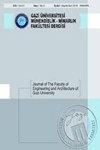不同壁厚和取向角下丝绕圆柱复合管轴压性能的实验研究
IF 1.1
4区 工程技术
Q3 ENGINEERING, MULTIDISCIPLINARY
Journal of the Faculty of Engineering and Architecture of Gazi University
Pub Date : 2023-06-27
DOI:10.24012/dumf.1304413
引用次数: 0
摘要
本文介绍了由玻璃纤维、碳纤维和凯夫拉纤维制成的空心圆柱形环氧树脂管在轴向压缩载荷作用下的性能和拉伸的实验研究结果。以玻璃、碳和凯夫拉纤维增强复合材料为材料,采用纤维缠绕法制备了空心圆柱管。在本研究中,空心圆柱形复合管具有恒定的外径(Ø17毫米),两种不同的内径(Ø12和Ø13毫米);(壁厚2.5毫米),高度80毫米。对两种不同壁厚和四种纤维取向角进行了实验研究。通过轴向加载试验研究了各试样的抗压强度。采用三种增强材料、四种缠绕角、两种壁厚共24种配置的复合材料试件,研究轴压应力对复合材料的影响。实验结果表明,聚合物增强材料、纤维缠绕角和壁厚对圆柱形复合管轴向受压应力有显著影响。结果表明:在轴压荷载作用下,各钢筋的压应力随取向角和壁厚的增大而增大,当取向角为90°时,压应力达到最大值;结果表明,玻璃/环氧树脂样品的轴压应力最大,为217 MPa,其次是碳/环氧树脂样品,为173 MPa,凯夫拉尔/环氧树脂样品为145 MPa。各试样的轴向压应力在90°取向角处最大,在15°取向角处最小。被发现值很低。观察到,随着壁厚的增加,所有增强材料的轴向压应力值都有所增加。 *关键:不要在论文标题或摘要中使用符号,特殊字符,脚注或数学。本文章由计算机程序翻译,如有差异,请以英文原文为准。
Experimental examination of the axial compression conduct of filament-wound cylindrical composite tubes at different wall thicknesses and orientation angles
This study presents the results of experimental research on the behavior and stretching of hollow cylindrical epoxy tubes made of glass, carbon, and kevlar fibers subjected to axial compression load. Hollow cylindrical tubes were fabricated by fiber winding method using glass, carbon, and kevlar fiber-reinforced composite materials. In this study, hollow cylindrical composite tubes with constant outer (Ø17 millimeters), two different inner diameters (Ø12 and Ø13 millimeters; 2 ve 2,5 millimeters wall thickness), and 80 millimeters in height. Experimental research was carried out for two dissimilar wall thicknesses and four fiber orientation angles. The compressive strengths of all samples were investigated experimentally by applying loads in the axial direction. Twenty-four configurations of composite specimens were fabricated (three reinforcement materials, four winding angles, and two wall thicknesses) to research the impact of axial compression stress. Experimental results revealed that polymer reinforcement material, fiber winding angle, and wall thickness have a significant impact on the compressive stress of cylindrical composite tubes as a result of applied load in the axial direction. The conclusions show that the compressive stress of all reinforcement rises as the orientation angle and wall thickness increase under an axial compression load, and the compressive stress reaches a maximum when the orientation angle is 90° under an axial compression load. It was observed that the axial compressive stress was highest in glass/epoxy samples with 217 MPa, followed by carbon/epoxy samples with 173 MPa and kevlar/epoxy samples with 145 MPa, respectively. The axial compressive stress of all samples was highest at a 90° orientation angle and lowest at a 15° orientation angle. were found to have low values. It was observed that the axial compressive stress value increased in all reinforcement materials as the wall thickness increased.
*CRITICAL: Do Not Use Symbols, Special Characters, Footnotes, or Math in Paper Title or Abstract.
求助全文
通过发布文献求助,成功后即可免费获取论文全文。
去求助
来源期刊

Journal of the Faculty of Engineering and Architecture of Gazi University
ENGINEERING, MULTIDISCIPLINARY-
CiteScore
1.90
自引率
45.50%
发文量
51
审稿时长
6-12 weeks
期刊介绍:
Gazi University Journal of the Faculty of Engineering and Architecture; Engineering qualifications described below and in the field of architecture research papers and invited articles by scanning is considered to be Turkish.
 求助内容:
求助内容: 应助结果提醒方式:
应助结果提醒方式:


